Food Loss and Waste in Meat Sector—Why the Consumption Stage Generates the Most Losses?
Abstract
1. Introduction
2. An Overview of the Food Loss and Waste Problem
3. Food Loss and Waste in Meat Sector
3.1. How Much Food Is Lost or Wasted in Meat Sector?
3.2. What Are the Causes of Food Loss and Waste in Meat Sector?
4. Food Waste Generated at the Stage of Consumption
5. Conclusions
Author Contributions
Funding
Institutional Review Board Statement
Informed Consent Statement
Data Availability Statement
Conflicts of Interest
References
- UNEP Food Waste Index Report. 2021. Available online: https://www.unep.org/resources/report/unep-food-waste-index-report-2021 (accessed on 3 March 2021).
- FAO, IFAD, UNICEF, WFP and WHO. Transforming food systems for affordable healthy diets. In The State of Food Security and Nutrition in the World 2020; FAO: Rome, Italy, 2020. [Google Scholar]
- Laborde, D.; Martin, W.; Swinnen, J.; Vos, R. COVID-19 risks to global food security. Science 2020, 369, 500–502. [Google Scholar] [CrossRef]
- Torero, M. Without Food there can be no exit from the Pandemic. Nature 2020, 580, 588–589. [Google Scholar] [CrossRef]
- Canali, M.; Amani, P.; Aramyan, L.; Gheoldus, M.; Moates, G.; Ostergren, K.; Silvennoinen, K.; Waldron, K.; Vittuari, M. Food waste drivers in Europe, from identification to possible interventions. Sustainability 2017, 9, 37. [Google Scholar] [CrossRef]
- Conrad, Z.; Niles, M.T.; Neher, D.A.; Roy, E.D.; Tichenor, N.E.; Jahns, L. Relationship between food waste, diet quality, and environmental sustainability. PLoS ONE 2018, 13, e0195405. [Google Scholar] [CrossRef] [PubMed]
- Bilska, B.; Tomaszewska, M.; Kołożyn-Krajewska, D.; Szczepański, K.; Łaba, R.; Łaba, S. Environmental aspects of food wastage in trade—A case study. Environ. Prot. Nat. Resour. 2020, 31, 24–34. [Google Scholar]
- Moult, J.A.; Allan, S.R.; Hewitt, C.N.; Berners-Lee, M. Greenhouse gas emissions of food waste disposal options for UK retailers. Food Policy 2018, 77, 50–58. [Google Scholar] [CrossRef]
- Bryngelsson, D.; Wirsenius, S.; Hedenus, F.; Sonesson, U. How can the EU climate targets be met? A combined analysis of technological and demand-side changes in food and agriculture. Food Policy 2016, 59, 152–164. [Google Scholar] [CrossRef]
- Cattaneo, A.; Federighi, G.; Vaz, S. The environmental impact of reducing food loss and waste: A critical assessment. Food Policy 2021, 98, 101890. [Google Scholar] [CrossRef]
- Kuiper, M.; Cui, H.D. Using food loss reduction to reach food security and environmental objectives—A search for promising leverage points. Food Policy 2021, 98, 101915. [Google Scholar] [CrossRef]
- Beretta, C.; Hellweg, S. Potential environmental benefits from food waste prevention in the food service sector. Resour. Conserv. Recycl. 2019, 147, 169–178. [Google Scholar] [CrossRef]
- Lipinski, B.; Hanson, C.; Lomax, J.; Kitinoja, L.; Waite, R.; Searchinger, T. Reducing Food Loss and Waste; World Resources Institute: Washington, DC, USA, 2013. [Google Scholar]
- Stephen, F.H.; Timothy, J.R. Food policy and household food waste. Am. J. Agric. Econ. 2019, 101, 600–614. [Google Scholar]
- Muriana, C. A focus on the state of the art of food waste/losses issue and suggestions for future researches. Waste Manag. 2017, 68, 557–570. [Google Scholar] [CrossRef]
- Calvo-Porral, C.; Medín, A.F.; Losada-L’opez, C. Can marketing help in tackling food waste? Proposals in developed countries. J. Food Prod. Mark. 2017, 23, 42–60. [Google Scholar] [CrossRef]
- Falcone, P.M.; Imbert, E. Bringing a Sharing Economy Approach into the Food Sector: The Potential of Food Sharing for Reducing Food Waste. In Food Waste Reduction and Valorisation; Morone, P., Papendiek, F., Tartiu, V., Eds.; Springer: Cham, Switzerland, 2017. [Google Scholar]
- Morone, P.; Falcone, P.M.; Tartiu, V.E. Food waste valorisation: Assessing the effectiveness of collaborative research networks through the lenses of a COST action. J. Clean. Prod. 2019, 238, 117868. [Google Scholar] [CrossRef]
- Girotto, F.; Alibardi, L.; Cossu, R. Food waste generation and industrial uses: A review. Waste Manag. 2015, 45, 32–41. [Google Scholar] [CrossRef] [PubMed]
- Lin, C.S.K.; Koutinas, A.A.; Stamatelatou, K.; Mubofu, E.B.; Matharu, A.S.; Kopsahelis, N.; Pfaltzgraff, L.A.; Clark, J.H.; Papanikolaou, S.; Kwan, T.H.; et al. Current and future trends in food waste valorization for the production of chemicals, materials and fuels: A global perspective. Biofuels Bioprod. Bioref. 2014, 8, 686–715. [Google Scholar] [CrossRef]
- Bräutigam, K.R.; Jörissen, J.; Priefer, C. The extent of food waste generation across EU27: Different calculation methods and the reliability of their results. Waste Manag. Res. 2014, 32, 683–694. [Google Scholar] [CrossRef]
- FUSIONS. Estimates of European Food Waste Levels. 2016. Available online: https://www.eufusions.org/phocadownload/Publications/Estimates%20of%20European%20food%20waste%20levels.pdf (accessed on 27 February 2021).
- Van Holsteijn, F.; Kemna, R.; Lee, P.; Sims, E. Optimal Food Storage Conditions in Refrigeration Appliances. Preparatory/Review Study on Commission Regulation (EC) No. 643/2009 and Commission Delegated Regulation (EU) No. 1060/2010—Complementary Research on Optimal Food Storage Conditions in Retrigger. 2017. Available online: https://www.vhk.nl/downloads/Reports/2017/VHK%20563%20FINAL%20REPORT%20Optimal%20food%20storage%20conditions%20in%20refrigeration%20appliances%20VHK%2020170217.pdf (accessed on 20 February 2021).
- Tisserant, A.; Pauliuk, S.; Merciai, S.; Schmidt, J.; Fry, J.; Wood, R.; Tukker, A. Solid Waste and the Circular Economy: A Global Analysis of Waste Treatment and Waste Footprints. J. Ind. Ecol. 2017, 21, 628–640. [Google Scholar] [CrossRef]
- Alexander, P.; Brown, C.; Arneth, A.; Finnigan, J.; Moran, D.; Rounsevell, M.D. Losses, inefficiencies and waste in the global food system. Agric. Syst. 2017, 153, 190–200. [Google Scholar] [CrossRef]
- Porter, S.D.; Reay, S.D.; Higgins, P.; Bomberg, E. A half-century of production-phase greenhouse gas emissions from food loss & waste in the global food supply chain. Sci. Total Environ. 2016, 571, 721–729. [Google Scholar]
- Vanham, D.; Bouraoui, F.; Leip, A.; Grizzetti, B.; Bidaglio, G. Lost water and nitrogen resources due to EU consumer food waste. Environ. Res. Lett. 2015, 10, 084008. [Google Scholar] [CrossRef]
- Chalak, A.; Abou-Daher, C.; Chaaban, J.; Abiad, M.G. The global economic and regulatory determinants of household food waste generation: A cross-country analysis. Waste Manag. 2016, 48, 418–422. [Google Scholar] [CrossRef] [PubMed]
- Delgado, L.; Schuster, M.; Torero, M. The reality of food losses: A new measurement methodology. In IFPRI Discussion Paper 1686; International Food Policy Research Institute (IFPRI): Washington, DC, USA, 2017. [Google Scholar]
- FAO. Moving forward on food loss and waste reduction. In The State of Food and Agriculture 2019; FAO: Rome, Italy, 2019. [Google Scholar]
- The Commission Delegated Decision (EU) of May, 3, 2019 Supplementing the Directive of the European Parliament and of the Council 2008/98/EC as Regards a Common Methods and Minimum Quality Requirements for the Uniform Measurement of Levels of Food Waste. Official Journal of Laws of the EU L 248/77. Available online: https://eur-lex.europa.eu/eli/dec_del/2019/1597/oj (accessed on 20 February 2021).
- Łaba, S.; Bilska, B.; Tomaszewska, M.; Łaba, R.; Szczepański, K.; Tul-Krzyszczuk, A.; Kosicka-Gębska, M.; Kołożyn-Krajewska, D. Próba oszacowania strat i marnotrawstwa żywności w Polsce (An Attempt to Estimate Food Loss and Waste in Poland). Przemysł Spożywczy 2019, 74, 10–18. [Google Scholar]
- Available online: https://ec.europa.eu/newsroom/dae/items/703095 (accessed on 20 February 2021).
- FAO. Agriculture, Foresty and Fishery Statistics—2019 Edition; European Union: Brussels, Belgium, 2019. [Google Scholar]
- Ritchie, H.; Roser, M. “Meat and Dairy Production”. Published Online at OurWorldInData.org. 2017. Available online: https://ourworldindata.org/meat-production (accessed on 20 February 2021).
- Gerber, P.J.; Steinfeld, H.; Henderson, B.; Mottet, A.; Opio, C.; Dijkman, J.; Falcucci, A.; Tempio, G. Tackling Climate Change through Livestock—A Global Assessment of Emissions and Mitigation Opportunities; Food and Agriculture Organization of the United Nations (FAO): Rome, Italy, 2013. [Google Scholar]
- Caldeira, C.; De Laurentiis, V.; Corrado, S.; Van Holsteijn, F.; Sala, S. Quantification of food waste per product group along the food supply chain in the European Union: A mass flow analysis. Res. Conserv. Recycl. 2019, 149, 479–488. [Google Scholar] [CrossRef] [PubMed]
- Lipiński, B. Why Does Animal-Based Food Loss and Waste Matter? Anim. Front. 2020, 10, 48–52. [Google Scholar] [CrossRef]
- Hodges, R.J.; Buzby, J.C.; Bennett, B. Postharvest losses and waste in developed and less developed countries: Opportunities to improve resource use. J. Agric. Sci. 2010, 149, 37–45. [Google Scholar] [CrossRef]
- Flanagan, K.; Robertson, K.; Hanson, C. Reducing Food Loss and Waste: Setting a Global Action Agenda; World Resources Institute: Washington, DC, USA, 2019. [Google Scholar]
- Ranganathan, J.; Vennard, D.; Waite, R.; Duman, P.; Lipinski, B.; Searchinger, T.; GLOBAGRI-WRR Model Authors. Shifting diets for a sustainable food future. In Installment 11 of Creating a Sustainable Food Future; Working Paper; World Resources Institute: Washington, DC, USA, 2016. [Google Scholar]
- Buzby, J.C.; Hyman, J. Total and per capita value of food loss in the United States. Food Policy 2012, 37, 561–570. [Google Scholar] [CrossRef]
- Abdulla, M.; Martin, R.C.; Gooch, M.; Jovel, E. The importance of quantifying food waste in Canada. J. Agric. Food Syst. Community Dev. 2013, 3, 137–151. [Google Scholar] [CrossRef]
- Gustavsson, J.; Cederberg, C.; Sonesson, U.; Emanuelsson, A. The Methodology of the FAO Study: Global Food Losses and Food Waste-Extent, Causes and Prevention; FAO: Rome, Italy, 2011. [Google Scholar]
- Enemark, P.S. Lavestekodødeligheditiår. 2015. Available online: http://www.seges.dk/Nyheder/lavestekodoedeligheditiaar.htm (accessed on 16 January 2021).
- Hartikainen, H.; Kisman Pinolehto, M.; Räikönen, R.; Kahiluoto, H. Food Waste in Primary Production and Food Processing (Finnish). Available online: http://jukuri.mtt.fi/handle/10024/485067 (accessed on 18 February 2021).
- Jaja, I.F.; Mushonga, B.; Geen, E.; Muchenje, V. Factors responsible for the post-slaughter loss of carcass and offal’s in abattoirs in South Africa. Acta Trop. 2018, 178, 303–310. [Google Scholar] [CrossRef]
- Falowo, A.B.; Fayemi, P.O.; Muchenje, V. Natural antioxidants against lipid-protein oxidative deterioration in meat and meat products: A review. Food Res. Int. 2014, 64, 171–181. [Google Scholar] [CrossRef] [PubMed]
- Dora, M.; Wesana, J.; Gellynck, X.; Seth, N.; Dey, B.; De Steur, H. Importance of sustainable operations in food loss: Evidence form the Belgian food processing industry. Ann. Oper. Res. 2020, 290, 47–72. [Google Scholar] [CrossRef]
- Kranert, M.; Hafner, G.; Barabosz, J.; Schneider, F.; Lebersorger, S.; Scherhaufer, S.; Schuller, H.; Leverenz, D. Determination of Discarded Food and Proposals for a Minimization of Food Wastage in Germany: Abridged Version; University Stuttgart Institute for Sanitary Engineering: Stuttgart, Germany, 2012. [Google Scholar]
- RASFF: The Rapid Alert System for Food and Feed 2018 Annual Report; Health and Consumers Directorate-General of the European Commission: Luxembourg, 2019.
- Bogataj, D.; Hudoklin, D.; Bogataj, M.; Dimovski, V.; Colnar, S. Risk Mitigation in a Meat Supply Chain with Options of Redirection. Sustainability 2020, 12, 8690. [Google Scholar] [CrossRef]
- Zhang, H.; Hortal, M.; Dobon, A.; Bermudez, J.M.; Lara-Lledo, M. The effect of active packaging on minimizing food losses: Life cycle assessment (LCA) of essential oil component-enabled packaging for fresh beef. Packag. Technol. Sci. 2015, 28, 761–774. [Google Scholar] [CrossRef]
- Henz, G.P.; Porpino, G. Food losses and waste: How Brazil is facing this global challenge? Hortic. Bras. 2017, 35, 472–482. [Google Scholar] [CrossRef]
- Eriksson, M.; Strid, I.; Hansson, P.A. Food losses in six Swedish retail stores: Waste of fruit and vegetables. In relation to quantitatives delivered. Res. Conserv. Recycl. 2012, 68, 14–20. [Google Scholar] [CrossRef]
- Katajajuuri, J.M.; Silvennoinen, K.; Hartikainen, H.; Heikkila, L.; Reinikainen, A. Food waste in the Finnish food chain. J. Clean. Prod. 2014, 73, 322–329. [Google Scholar] [CrossRef]
- Krajewski, K.; Światkowska, M.; Łaba, S.; Szczepański, K. Losses and Waste in Meat 30 Supply Chain, and the Needs of Product Management and Market Communication. In Proceedings of the SUM2018/4th Symposium on Urban Mining and Circular Economy 32, Bergamo, Italy, 21–23 May 2018; Available online: https://www.urbanmining.it/ (accessed on 18 February 2021).
- Magalhães, V.S.M.; Ferreira, L.M.D.F.; da Silva César, A.; Bonfim, R.M.; Silva, C. Food loss and waste in the Brazilian beef supply chain: An empirical analysis. Int. J. Logist. Manag. 2021, 32, 214–236. [Google Scholar] [CrossRef]
- Martin-Rios, C.; Demen-Meier, C.; Gössling, S.; Cornuz, C. Food waste management innovations in the foodservice industry. Waste Manag. 2018, 79, 196–206. [Google Scholar] [CrossRef]
- Christ, K.L.; Burritt, R. Material flow cost accounting for food waste in the restaurant industry. Br. Food J. 2017, 119, 600–612. [Google Scholar] [CrossRef]
- Massow, M.V.; McAdams, B. Table scraps: An evaluation of plate waste in restaurants. J. Foodserv. Bus. Res. 2015, 18, 437–453. [Google Scholar] [CrossRef]
- Mirosa, M.; Munro, H.; Mangan-Walker, E.; Pearson, D. Reducing waste of food left on plates. Br. Food J. 2016, 118, 2326–2343. [Google Scholar] [CrossRef]
- Vogliano, C.; Brown, K. The state of America’s wasted food and opportunities to make a difference. J. Acad. Nutr. Diet. 2016, 116, 1199–1207. [Google Scholar] [CrossRef]
- Freedman, M.R.; Brochado, C. Reducing portion size reduces food intake and plate waste. Obesity 2010, 18, 1864–1866. [Google Scholar] [CrossRef] [PubMed]
- Ofei, K.T.; Holst, M.; Rasmussen, H.H.; Mikkelsen, B.E. Effect of meal portion size choice on plate waste generation among patients with different nutritional status. An investigation using Dietary Intake Monitoring System (DIMS). Appetite 2015, 91, 157–164. [Google Scholar] [CrossRef] [PubMed]
- Vermote, M.; Versele, V.; Stok, M.; Mullie, P.; D’Hondt, E.; Deforche, B.; Clarys, P.; Deliens, T. The effect of a portion size intervention on French fries consumption, plate waste, satiety and compensatory caloric intake: An on-campus restaurant experiment. Nutr. J. 2018, 17, 1–12. [Google Scholar] [CrossRef]
- Sakaguchi, L.; Pak, N.; Potts, M.D. Tackling the issue of food waste in restaurants: Options for measurement method, reduction and behavioral change. J. Clean. Prod. 2018, 180, 430–436. [Google Scholar] [CrossRef]
- Varela, M.C.M.S.; Carvalho, D.R.; Oliveira, R.M.A.; Dantas, M.G.S. O Custo dos Desperdícios: Um Estudo de Caso No Restaurante Universitário da Universidade Federal Do Rio Grande Do Norte. In Proceedings of the Congresso Brasileiro de Custos, Iguazu River Mouth, Brazil, 11–13 November 2015; p. 16. [Google Scholar]
- Neff, R.A.; Spiker, M.; Rice, C.; Schklair, A.; Greenburg, S.; Leib, E.B. Misunderstood food date labels and reported food discards: A survey of U.S. consumer attitudes and behaviors. Waste Manag. 2019, 86, 123–132. [Google Scholar] [CrossRef]
- Bilska, B.; Tomaszewska, M.; Kołożyn-Krajewska, D. Managing the Risk of Food Waste in Foodservice Establishment. Sustainability 2020, 12, 2050. [Google Scholar] [CrossRef]
- Parfitt, J.P.; Barthel, M.; Macnaughton, S. Food waste within food supply chains: Quantification and potential for change to 2050. Philos. Trans. R. Soc. Biol. Sci. 2010, 365, 3065–3081. [Google Scholar] [CrossRef]
- Ziegler, G.; Floros, J.D. A future perspective to mitigate food losses. In The Role of Food Science and Technology; IFT 2011 Annual Meeting & Food Expo.: New Orleans, LA, USA, 2011. [Google Scholar]
- Qi, D.; Lai, W.; Roe, B.E. Food waste declined more in rural Chinese households with livestock. Food Policy 2021, 98, 101893. [Google Scholar] [CrossRef]
- Martin-Rios, C.; Hofmann, A.; Mackenzie, N. Sustainability-Oriented Innovations in Food Waste Management Technology. Sustainability 2021, 13, 210. [Google Scholar] [CrossRef]
- Reynolds, C.; Goucher, L.; Quested, T.; Bromley, S.; Gillick, S.; Wells, V.K.; Evans, D.; Koh, L.; Kanyama, A.C.; Katzeff, C.; et al. Review: Consumption-stage food waste reduction interventions—What works and how to design better interventions. Food Policy 2019, 83, 7–27. [Google Scholar] [CrossRef]
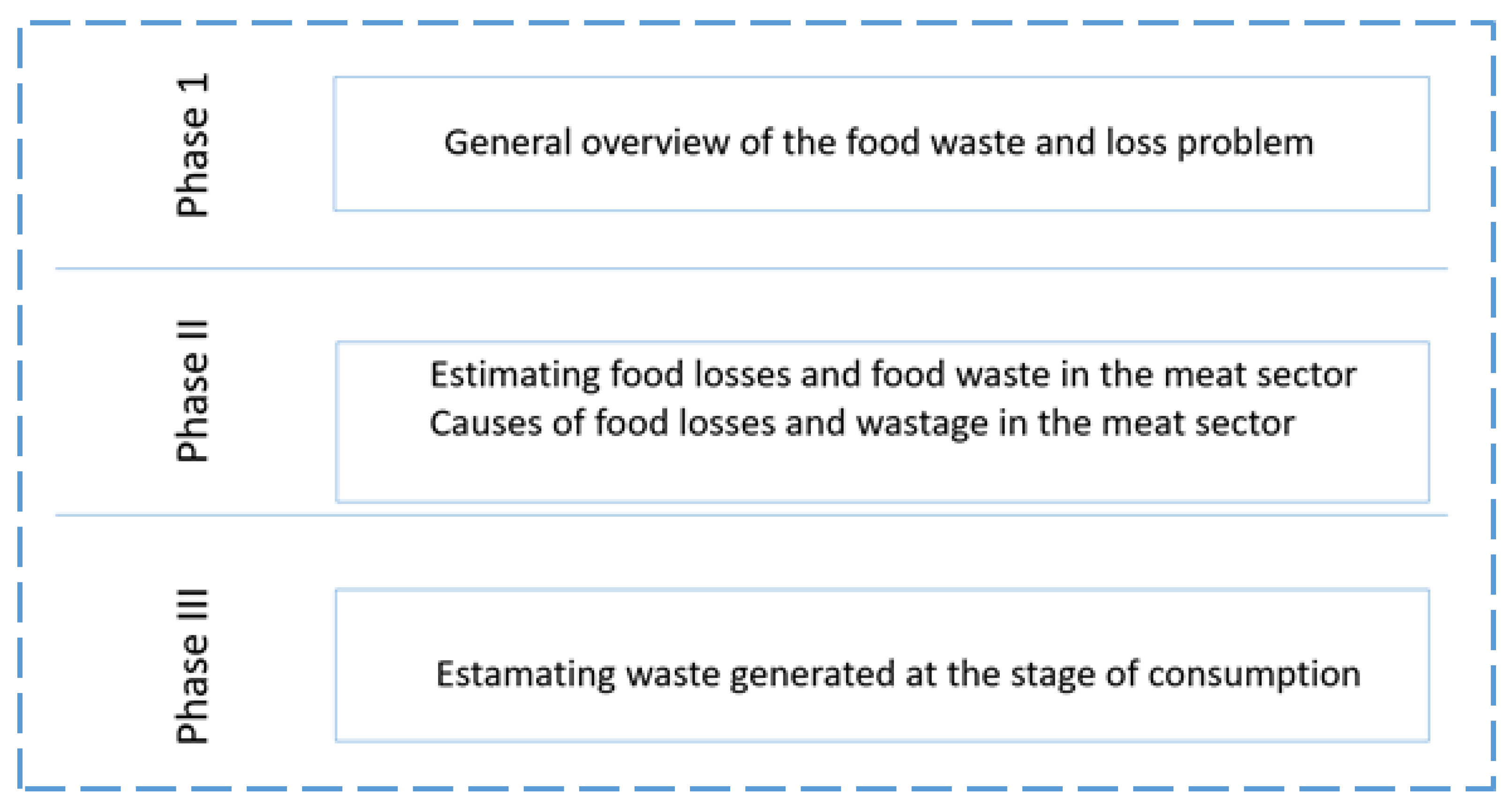
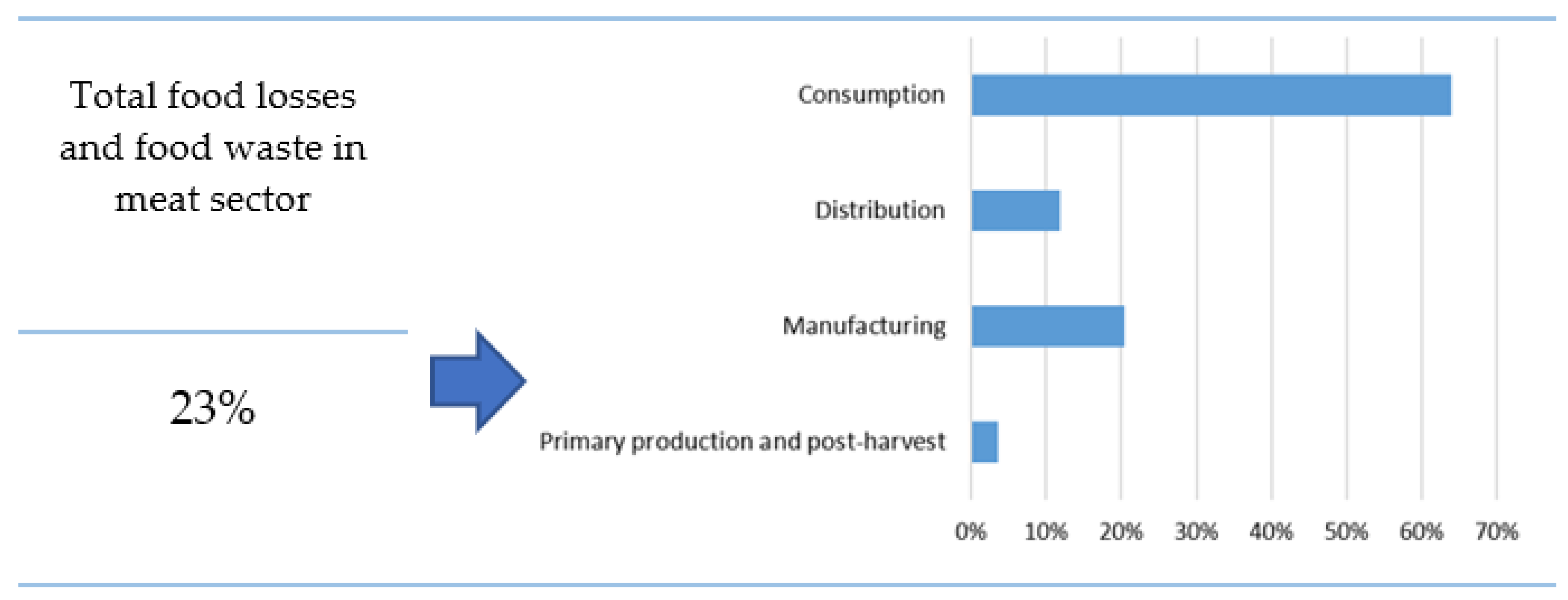
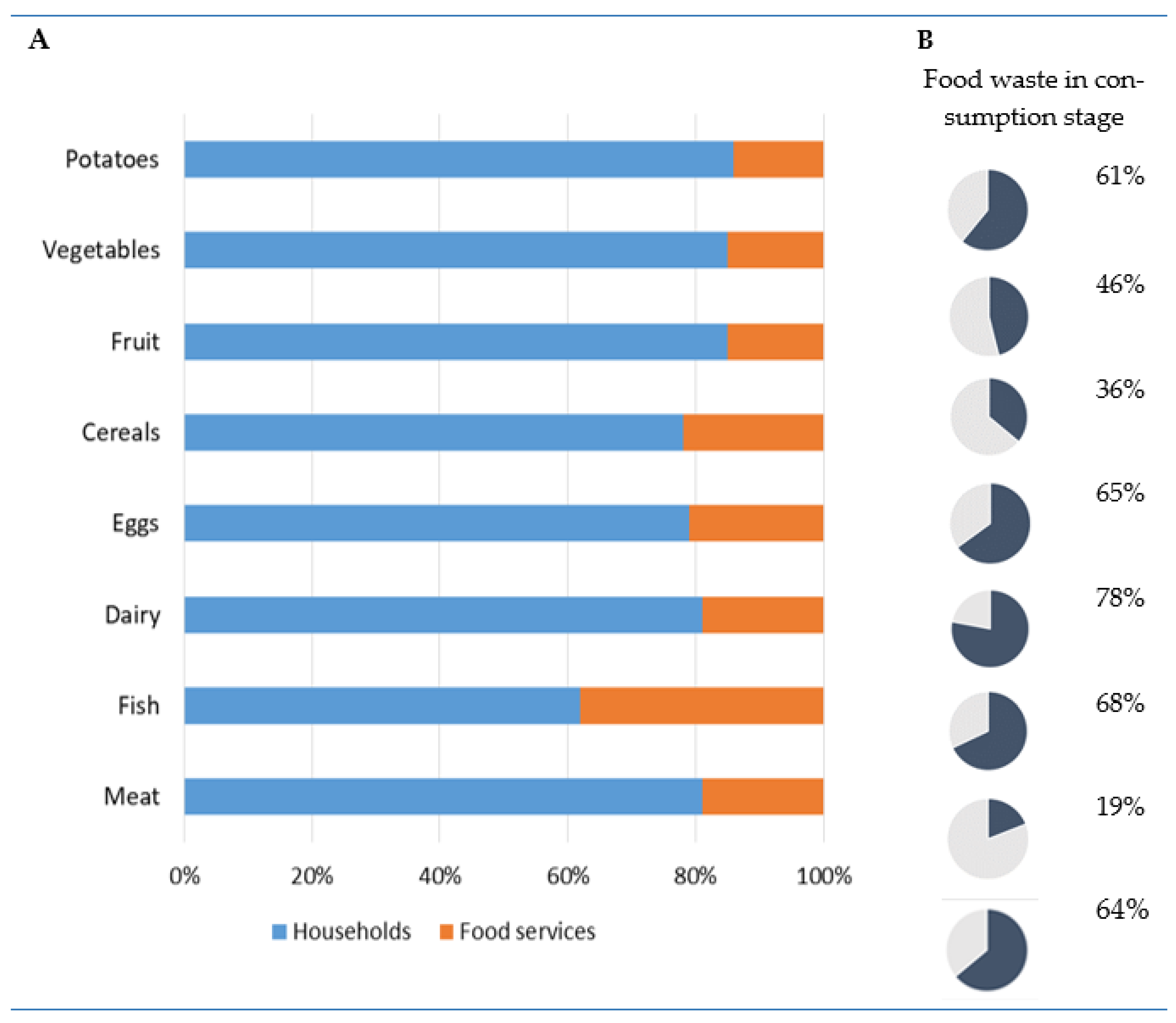
| Total Food Waste Quantification Including Zones and Year of Data Collection | Share of Food Waste in the Stages of the Food Supply Chain | References |
|---|---|---|
| 289 kg p−1 y−1 (data from EU27 in 2006) | 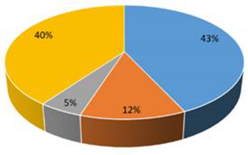 | [21] |
| 173 kg p−1 y−1 (data from EU28 in 2012) | 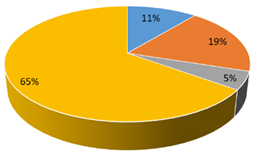 | [22] |
| 290 kg p−1 y−1 (data from EU in 2011) | 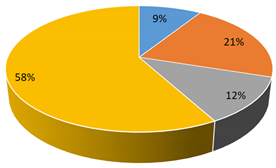 | [23] |
| 223 kg p−1 y−1 (global data from 48 world regions in 2007) | 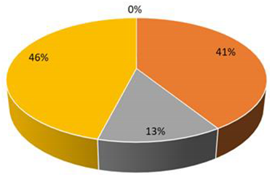 | [24] |
 | ||
| Stage | Causes | References |
|---|---|---|
| Consumption | Misunderstanding/lack of knowledge about labeling | [69] |
| Improper storage, kitchen preparation, service, leftovers and consumer plate waste | [60] | |
| Consumer confusion over ‘‘use-by’’ and ‘‘best before’’ dates so that food is discarded in packaging | [71] | |
| Preparation of too much food Inadequate staff qualifications The purchase of poor-quality products | [70] | |
| Psychological tastes, attitudes and preferences leading to plate waste/scrapings, e.g., human aversion, such as ‘‘I don’t eat that,’’ or refusal to eat a food for religious reasons.’’ | [72] | |
| Inadequate meal planning, daily user frequency, food preferences and employee training in preparing and portioning foods | [68] |
Publisher’s Note: MDPI stays neutral with regard to jurisdictional claims in published maps and institutional affiliations. |
© 2021 by the authors. Licensee MDPI, Basel, Switzerland. This article is an open access article distributed under the terms and conditions of the Creative Commons Attribution (CC BY) license (https://creativecommons.org/licenses/by/4.0/).
Share and Cite
Karwowska, M.; Łaba, S.; Szczepański, K. Food Loss and Waste in Meat Sector—Why the Consumption Stage Generates the Most Losses? Sustainability 2021, 13, 6227. https://doi.org/10.3390/su13116227
Karwowska M, Łaba S, Szczepański K. Food Loss and Waste in Meat Sector—Why the Consumption Stage Generates the Most Losses? Sustainability. 2021; 13(11):6227. https://doi.org/10.3390/su13116227
Chicago/Turabian StyleKarwowska, Małgorzata, Sylwia Łaba, and Krystian Szczepański. 2021. "Food Loss and Waste in Meat Sector—Why the Consumption Stage Generates the Most Losses?" Sustainability 13, no. 11: 6227. https://doi.org/10.3390/su13116227
APA StyleKarwowska, M., Łaba, S., & Szczepański, K. (2021). Food Loss and Waste in Meat Sector—Why the Consumption Stage Generates the Most Losses? Sustainability, 13(11), 6227. https://doi.org/10.3390/su13116227







